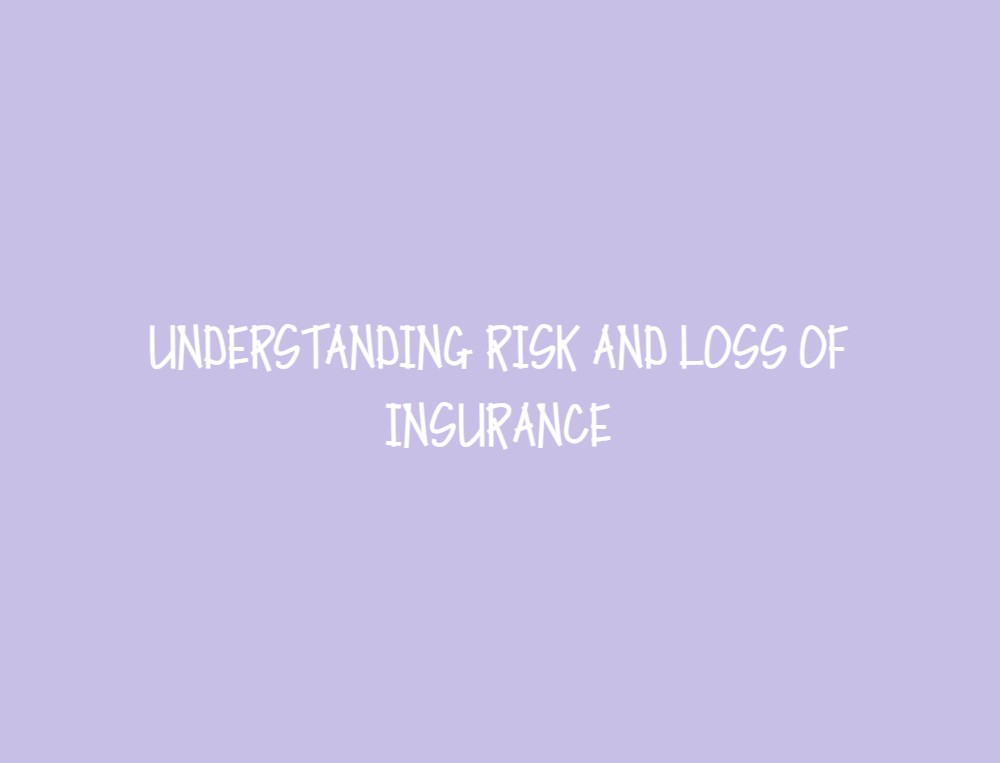
12 October, 2023 19:39

Insurance is a contract between an individual or entity (the insured) and an insurance company (the insurer) in which the insured pays regular premiums in exchange for financial protection against certain risks or losses. The purpose of insurance is to mitigate the potential financial impact of unexpected events or accidents.
In this article I’m going to discuss about risk and loss of Insurance. Please have a look carefully.
Risk refers to the possibility of a loss or negative outcome occurring. It can arise from various sources, such as accidents, natural disasters, theft, or illness. Insurance helps manage these risks by providing compensation or coverage for the financial losses incurred due to the insured event.
Loss, in the context of insurance, refers to the actual occurrence of the event that triggers a claim. For example, if a person’s house is insured against fire, the loss occurs when the fire actually damages the property. The insurer then evaluates the claim and compensates the insured based on the terms and conditions of the insurance policy.
Insurance companies assess risks associated with various events and determine the premiums to charge their policyholders based on these risks. The premiums collected from many policyholders help create a pool of funds that can be used to pay for claims when losses occur. The insurer aims to balance the premiums collected with the potential claims payouts to ensure the financial sustainability of the insurance company.
When an insured event occurs, the policyholder submits a claim to the insurance company, providing the necessary documentation and evidence to support the claim. The insurer evaluates the claim and determines whether it falls within the terms and conditions of the policy. If approved, the insurer compensates the insured for the covered losses, up to the limits specified in the policy.
It’s important to note that insurance policies typically have exclusions, deductibles, and limits. Exclusions are specific events or circumstances that are not covered by the policy. Deductibles are the amounts that the insured must pay out of pocket before the insurance coverage kicks in. Limits refer to the maximum amount that the insurer will pay for a particular claim or within a specified time period.
Understanding the risks covered, the exclusions, deductibles, and limits of an insurance policy is crucial to ensure that you have appropriate coverage for your needs. It’s advisable to carefully review the terms and conditions of the policy and ask the insurance company any questions you may have before purchasing or renewing insurance.
Insurance is a complex and multifaceted concept that plays a crucial role in managing risks and protecting individuals, businesses, and assets from potential financial losses. To fully grasp the intricacies of insurance, it is important to delve deeper into its fundamental principles, types of coverage, risk assessment, and the overall importance of insurance in today’s society.
At its core, insurance functions as a risk transfer mechanism. It allows individuals or entities to transfer the potential financial burden of a loss to an insurance company in exchange for regular premium payments. By pooling together premiums from many policyholders, insurance companies can accumulate funds that are then used to compensate those who experience covered losses.
There are various types of insurance coverage available, each designed to address specific risks. Some common types of insurance include:
Property Insurance
This type of insurance protects against damage or loss to property, such as homes, buildings, or personal belongings. It typically covers perils such as fire, theft, vandalism, and natural disasters like storms or earthquakes.
Auto Insurance
Auto insurance provides coverage for vehicles against damage, theft, or accidents. It includes both liability insurance (covering damages to others in an accident) and comprehensive or collision coverage (covering damage to one’s own vehicle).
Health Insurance
Health insurance offers coverage for medical expenses, including hospitalization, doctor visits, and medications. It helps individuals manage the high costs of healthcare and ensures access to necessary medical services.
Life Insurance
Life insurance provides a death benefit to beneficiaries in the event of the insured person’s death. It helps protect dependents and loved ones financially by providing funds to cover expenses, debts, or future financial needs.
Liability Insurance
Liability insurance protects individuals or businesses from legal claims or lawsuits due to negligence or damage caused to others. It includes general liability, professional liability (e.g., malpractice insurance for doctors), and product liability (covering damages caused by a defective product).
Disability Insurance
Disability insurance offers income replacement in the event an individual becomes unable to work due to an injury or illness. It helps provide financial stability during periods of disability.
Insurance companies employ various methods to assess and manage risks. They rely on actuarial analysis, statistical data, and historical patterns to estimate the likelihood of a loss occurring and the potential magnitude of the loss. This risk assessment enables insurance companies to set premiums that align with the level of risk posed by the insured individual or entity.
Factors such as age, health status, driving record, location, and the value of insured assets are taken into account when determining insurance premiums. Policyholders who present a higher risk are generally charged higher premiums, as they are more likely to experience a loss.
To protect themselves from excessive losses, insurance companies also implement mechanisms such as deductibles and policy limits. Deductibles are the amounts policyholders must pay out of pocket before the insurance coverage kicks in. They serve as a way to share the risk between the insured individual and the insurance company. Policy limits, on the other hand, establish the maximum amount an insurer will pay for a covered loss.
Exclusions are another important aspect of insurance policies. These are specific events, conditions, or circumstances that are not covered by the policy. For example, a property insurance policy may exclude coverage for damages caused by floods or earthquakes. It is crucial for policyholders to thoroughly review their policies to understand the exclusions and ensure they have appropriate coverage for their specific needs.
In the event of a loss, policyholders are required to submit a claim to their insurance company. This involves providing documentation and evidence to support the claim, such as police reports, medical records, or invoices for repairs. The insurer then evaluates the claim based on the policy terms and conditions. If the claim is approved, the insurer will compensate the policyholder for the covered losses, up to the policy limits.
Insurance plays a vital role in society by providing individuals and businesses with financial security and peace of mind. It encourages risk-taking and entrepreneurship by mitigating the potential consequences of failure. For example, a business owner may feel more comfortable starting a new venture if they have adequate business insurance to protect against unforeseen risks.
Insurance also helps individuals and families recover from unexpected events, such as accidents, illnesses, or natural disasters. Without insurance, the financial burden of such events could be devastating, leading to bankruptcy, homelessness, or significant hardship.
Furthermore, insurance contributes to the overall stability of the economy. When losses occur, insurance companies bear the financial responsibility, preventing individuals and businesses from shouldering the full burden. This allows for quicker recovery and minimizes the impact on the overall economy.
In conclusion, insurance is a vital tool for managing risks and protecting against potential financial losses. It operates by transferring the risk from individuals or entities to insurance companies, which collect premiums and provide compensation in the event of a covered loss. By understanding the types of coverage available, the risk assessment process, and the importance of thorough policy review, individuals and businesses can make informed decisions to protect their assets and financial well-being.
আপনার মন্তব্য